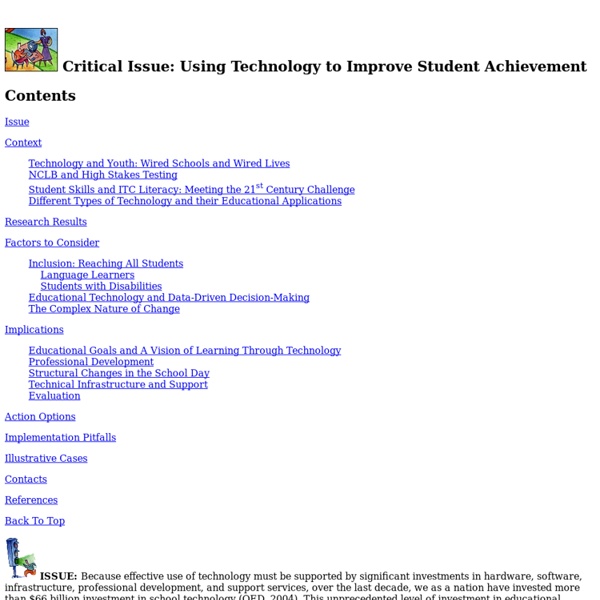bar2007
Un guide d'action de plus en plus précis Christian Barrette, chargé de projet (Association pour la recherche au collégial (ARC)) En 2005, le bulletin Clic publiait les conclusions d’une métasynthèse des résultats d’expériences d’intégration pédagogique des TIC dans les collèges du Québec. Ce travail, que nous avons réalisé à l'initiative et avec le soutien de l’Association pour la recherche au collégial (ARC), s’inscrit dans les efforts de concertation des différents acteurs du réseau dans le domaine de l’intégration des TIC. C’est dans le mandat de l’ARC de soutenir la recherche dans le milieu collégial, d’où son intérêt à proposer une démarche visant à récupérer 20 ans de recherche portant sur les effets de l’intégration pédagogique des TIC dans l’enseignement. La démarche que nous avons retenue il y a deux ans pour faire le point quant aux effets de l’intégration pédagogique des TIC sur l’apprentissage fut celle d’une métasynthèse. Valeur heuristique du modèle de causalité Figure 1.
Goal Setting and Achievement
Bib2000
Ressource pédagogique Description bibliographique Auteur : Bibeau, Robert Éditeur : La Vitrine APO. Page source : Ntic.org : le portail de l'intégration des TIC dans l'enseignement, Langue : français Date de publication : Description du contenu Spécialité : Sciences de la société - Education - Nouvelles technologies éducatives Mots clés : intégration des TICE ; Internet ; multimédia ; objectif pédagogique ; activité d'apprentissage ; indexation Table des matières : 1. Résumé : Ce guide a été conçu dans le but d'aider les éducateurs et les éducatrices dans la réalisation d'un projet pédagogique mettant à contribution les ressources de l'Internet ou du multimédia à l'école ou au collège. Informations pédagogiques Niveau d'études : 2e cycle Pré-requis : Etre capable d'élaborer un scénario pédagogique simple (public, objectifs, tâches, évaluation) Objectifs pédagogiques : Accès à la ressource gratuit Format : URL de référence :
Differentiation of Instruction in the Elementary Grades
Differentiation of Instruction in the Elementary Grades. ERIC Digest. by Tomlinson, Carol Ann In most elementary classrooms, some students struggle with learning, others perform well beyond grade-level expectations, and the rest fit somewhere in between. Within each of these categories of students, individuals also learn in a variety of ways and have different interests. At its most basic level, differentiation consists of the efforts of teachers to respond to variance among learners in the classroom. Content. Process. Products. Learning Environment. A simple answer is that students in the elementary grades vary greatly, and if teachers want to maximize their students' individual potential, they will have to attend to the differences. The most important factor in differentiation that helps students achieve more and feel more engaged in school is being sure that what teachers differentiate is high-quality curriculum and instruction. There is no recipe for differentiation. Sternberg, R.
Moo2011
The PDF file you selected should load here if your Web browser has a PDF reader plug-in installed (for example, a recent version of Adobe Acrobat Reader). If you would like more information about how to print, save, and work with PDFs, Highwire Press provides a helpful Frequently Asked Questions about PDFs. Alternatively, you can download the PDF file directly to your computer, from where it can be opened using a PDF reader. To download the PDF, click the Download link above. Fullscreen Fullscreen Off This work is licensed under a Creative Commons Attribution 3.0 License.
Dewey Quotes
Before delving into the world of CL it would be most appropriate to look first at what some of the experts on CL learning have said. Their research and writing has formed the theoretical and practical basis for a variety of CL paradigms used today. Many of the issues dealt with by these CL theorists and practitioners are still with us today. The adoption of CL as a favored teaching paradigm is a slow process and will require substantial commitments from policy makers, administrators and faculty. You will see this as we start our review by quoting the father of modern education, John Dewey, who over 80 years ago alerted us to the difficulties inherent with establishing this educational paradigm. Other authors quoted in this section are Kenneth Bruffee, David and Roger Johnson, Robert Slavin, The emphasis in school upon this particular tool has, however, its dangers-dangers which are not theoretical but exhibited in practice. page 38-39 trail on their own (Johnson & Johnson 1987, 1988).
Lan2009
Using Technology to Enhance Engaged Learning for At-Risk Students
ISSUE: An increasing number of educators are calling for high standards and challenging learning activities for at-risk students. New technologies can provide meaningful learning experiences for all children, especially those at risk of educational failure. Schools that capitalize on the relationship between technology and education reform will help students to develop higher order skills and to function effectively in the world beyond the classroom. Achieving such fundamental change, however, requires a transformation of not only the underlying pedagogy (basic assumptions about the teaching and learning process) but also the kinds of technology applications typically used in classrooms serving at-risk students. OVERVIEW: The vision of classrooms structured around student involvement in challenging, long-term projects and focused on meaningful, engaged learning is important for all students. Today, educational researchers are calling for very different uses of technology. Teachers:



